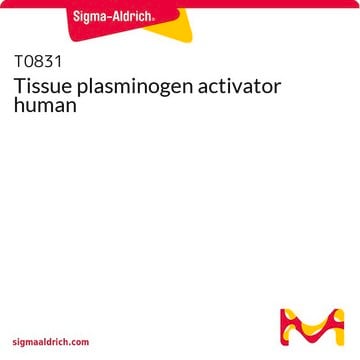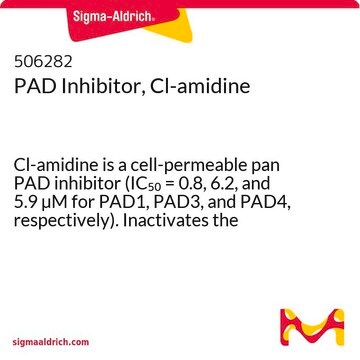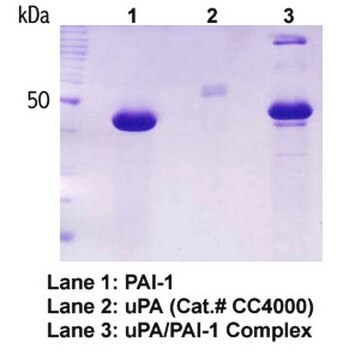528205
Plasminogen Activator Inhibitor-1, Human, Recombinant
The Plasminogen Activator Inhibitor-1, Human, Recombinant controls the biological activity of Plasminogen Activator. This small molecule/inhibitor is primarily used for Protease Inhibitors applications.
Sinónimos:
PAI-1
Iniciar sesiónpara Ver la Fijación de precios por contrato y de la organización
About This Item
Código UNSPSC:
12352200
NACRES:
NA.77
Productos recomendados
Nivel de calidad
Análisis
≥98% (SDS-PAGE)
formulario
liquid
fabricante / nombre comercial
Calbiochem®
condiciones de almacenamiento
OK to freeze
avoid repeated freeze/thaw cycles
Condiciones de envío
wet ice
temp. de almacenamiento
−70°C
Descripción general
PAI-1 is the primary inhibitor of both tissue plasminogen activator (tPA) and urokinase (uPA). PAI-1 can exist either in an active inhibitory conformation or in an inactive or latent conformation. This highly purified preparation has not been exposed to denaturing conditions and has been chromatographically purified of latent material. PAI-1 is a marker for acute myocardial infarction and several thrombolytic disorders. Protects platelets against the inhibitory effects of plasma. Reported to be an important prognostic factor in breast cancer patients. PAI-1 is highly stable when stored at or below pH 6.6.
Primary inhibitor of both tissue plasminogen activator (tPA) and urokinase (uPA). PAI-1 is synthesized by vascular epithelium and hepatocytes. Used as a marker for acute myocardial infarction and in the diagnosis of several thrombolytic disorders. Protects platelets against the inhibitory effects of plasma. Shown to have a role complimentary to that of α2-anti-plasmin. Elevated levels are found in subjects with accelerated coronary artery disease. PP1 activity may limit the extent of metastasis, since uPA activity is a major contributory factor promoting dissolution of tumor matrix and basement membrane. May serve as an independent and strong prognosticator in breast cancer patients. Patients having elevated levels of PAI-1 in their primary tumors are more prone to relapse. Can exist either in an active inhibitory conformation or in an inactive or latent conformation. This highly purified preparation has not been exposed to denaturing conditions and has been chromatographically purified free of the inactive material.
Acciones bioquímicas o fisiológicas
Cell permeable: no
Primary Target
Tissue plasminogen activator (tPA) and urokinase (uPA)
Tissue plasminogen activator (tPA) and urokinase (uPA)
Product does not compete with ATP.
Reversible: no
Advertencia
Toxicity: Standard Handling (A)
Forma física
In 150 mM NaCl, 50 mM sodium phosphate buffer, 1 mM EDTA, pH 6.6.
Reconstitución
Following initial thaw, aliquot and freeze (-70°C).
Otras notas
Vaughan, D.E., et al. 1995. J. Clin. Invest. 95, 995.
Dimitri, G., et al. 1993. Boll. Chim. Farmaceutico 132, 272.
Janicke, F., et al. 1993. Breast Cancer Res. Treatment 24, 195.
Klasser, K.J., et al. 1993. Coron. Artery Dis. 4, 713.
Robbie, L.A., et al. 1993. Thromb. Hemost.70, 307.
Lawrence, D., et al. 1989. Eur. J. Biochem.186, 523.
Collen, D. and Lijnen, H.R. 1987. In The Molecular Basis of Blood Diseases (Stamatoyannopoulus, G., et al. Eds.) W.B. Saunders
Ginsberg, D., et al. 1986. J. Clin. Invest.78, 1673.
Vassalli, J.D., et al. 1985. J. Cell Biol.100, 86.
Dimitri, G., et al. 1993. Boll. Chim. Farmaceutico 132, 272.
Janicke, F., et al. 1993. Breast Cancer Res. Treatment 24, 195.
Klasser, K.J., et al. 1993. Coron. Artery Dis. 4, 713.
Robbie, L.A., et al. 1993. Thromb. Hemost.70, 307.
Lawrence, D., et al. 1989. Eur. J. Biochem.186, 523.
Collen, D. and Lijnen, H.R. 1987. In The Molecular Basis of Blood Diseases (Stamatoyannopoulus, G., et al. Eds.) W.B. Saunders
Ginsberg, D., et al. 1986. J. Clin. Invest.78, 1673.
Vassalli, J.D., et al. 1985. J. Cell Biol.100, 86.
Información legal
CALBIOCHEM is a registered trademark of Merck KGaA, Darmstadt, Germany
Código de clase de almacenamiento
10 - Combustible liquids
Clase de riesgo para el agua (WGK)
WGK 1
Punto de inflamabilidad (°F)
Not applicable
Punto de inflamabilidad (°C)
Not applicable
Certificados de análisis (COA)
Busque Certificados de análisis (COA) introduciendo el número de lote del producto. Los números de lote se encuentran en la etiqueta del producto después de las palabras «Lot» o «Batch»
¿Ya tiene este producto?
Encuentre la documentación para los productos que ha comprado recientemente en la Biblioteca de documentos.
Nuestro equipo de científicos tiene experiencia en todas las áreas de investigación: Ciencias de la vida, Ciencia de los materiales, Síntesis química, Cromatografía, Analítica y muchas otras.
Póngase en contacto con el Servicio técnico








